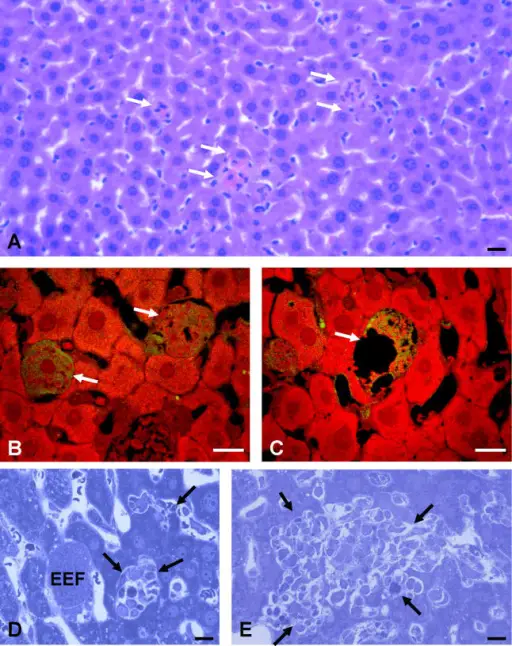
Transmigrating Plasmodium Sporozoites Leave Behind a Trail of Dead Hepatocytes (A) Three hours after infection with 5 × 106P. berghei salivary gland sporozoites, a mouse liver contains small clusters of necrotic hepatocytes that have been infiltrated by inflammatory cells (arrows). (B) Four hours after intravenous infection with 5 × 106P. yoelii sporozoites, a mouse liver contains individual or small clusters of necrotic hepatocytes (arrows). (C) Six hours after infection, the signs of hepatocytic damage appear more severe in another mouse liver (arrow). (D) Forty hours after inoculation of 2 × 106P. yoelii sporozoites, small infiltrates of inflammatory cells (arrows) block the lumina of some sinusoids while maturing EEFs are free of any inflammatory reaction. (E) Fifty hours after infection with 2 × 106P. yoelii sporozoites, the size of the inflammatory infiltrates (arrows) has increased. Stains used: (A) paraffin section stained with H&E, (B and C) frozen sections stained with Evans blue, (D and E) semithin Epon sections stained with Toluidine blue. Bars = 20 μm. Intravital observation of Plasmodium berghei sporozoite infection of the liver: Frevert U, Engelmann S, Zougbédé S, Stange J, Ng B, Matuschewski K, Liebes L, Yee H - PLoS biology (2005). Not altered. CC.
Infectious disorders of the liver are the disorders caused by microbial pathogens on the liver.
Infectious disorders of the liver include:
- Viral hepatitis
- Bacterial liver infections
- Helminthic liver infections
- Parasitic liver infections
